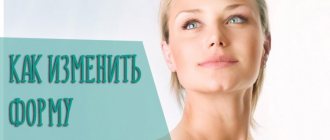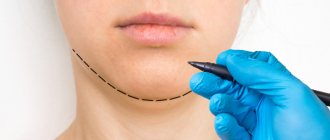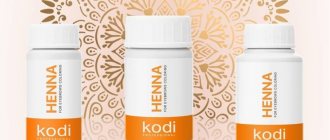The contour of her neck and the appearance of her skin inexorably reveal her age. Gradually, deep transverse folds and wrinkles appear on the front surface of the neck; the skin along the lower edge of the face and chin quickly loses its tone, stretches and begins to sag. The subcutaneous muscle of the neck, the platysma, is responsible for the appearance of this area. With age, it loses elasticity, the edges of the muscle along the midline can diverge, and then longitudinal “cords” (“turkey neck”) form on the neck, and the cervical-mental angle also increases. Normally, this angle should be no more than 120 degrees. The bifurcated edges of the neck muscle are especially visible in thin people when the neck muscle is tense and the head is moderately turned to the side. Platysmaplasty will help eliminate such changes, give the skin of the neck smoothness and give the chin an elegant, emphasized contour.
In some cases, with a low position of the hyoid bone on the neck, platysmoplasty may not give a pronounced effect due to the peculiarities of the anatomical structure. Therefore, in such a situation, platysmoplasty must be combined with an operation to increase the projection of the chin with an implant. These two complementary operations are performed through one small incision in the mental fold. As a result, a pronounced cervical-mental angle can be achieved, which should be no more than 120 degrees.
What is a neck lift
A neck lift is an operation on the subcutaneous neck muscle, and is performed to smooth out the skin of the neck and eliminate bifurcation of the subcutaneous neck muscle, eliminate sagging skin along the lower edge of the face and chin and achieve a rejuvenation effect. This operation significantly reduces the cervical-mental angle. More often it is performed in conjunction with operations such as SMAS-lifting, mini-S-lifting, liposuction and laser liposuction of the neck and chin and lower face, removal of the fatty body of the cheek (Bishat's lumps) and mentoplasty (increasing the projection of the chin). If there is unexpressed sagging of the tissues in the neck and chin, endoscopic equipment and endovideo control may be required to suturing the edges of the neck muscle. This operation is called endoscopic neck plastic surgery and is performed through small punctures in the same way as neck liposuction.
Jaw Information
The jaws are a pair of bones that form the base of the mouth and teeth (see Figure 1).
- The maxilla is the upper jaw bone.
- The mandible is the lower jaw bone.
- The temporomandibular joint is where the lower jaw attaches to the skull.
- The masseter muscle is the muscle that connects the lower jaw to the skull.
Figure 1. Bones and muscles of the jaws
The opening and closing of the mouth is controlled by many muscles and nerves located around the jaws. Most people can open their mouth 35–55 millimeters (1.4–2.2 inches), which is the width of three fingers (see Figure 2).
Figure 2. Normal open mouth height
to come back to the beginning
Operation description
Neck lift surgery is usually performed under intravenous anesthesia. The scope of the operation and the specifics of the technique depend on the elasticity of the skin, weight, age of the patient and the nature of changes in the neck area. If the patient is overweight, platysmoplasty can be combined with liposuction of the neck and chin. If the skin is severely stretched (for example, after significant weight loss or with serious age-related changes), the surgeon can remove its excess.
An incision is made in the submental fold; if necessary, additional small incisions are made behind the ears. The doctor places the incisions in natural folds, which improves the cosmetic qualities of the scar and additionally disguises it. As a result, a thin cosmetic seam looks like a fold of skin. The next stage is strengthening the platism. To do this, the separated edges of the muscle are sutured along the midline. If necessary, additional wedge-shaped excision of the inner edge of the platysma helps to better emphasize the contour of the angle between the neck and chin. If there is pronounced subplatysmal fat, its resection (removal) is also performed.
Then the wound is stitched layer by layer while maintaining uniform tension of the muscle, and a cosmetic suture is applied to the skin at the site of the incisions. To consolidate the effect and reduce postoperative swelling, a pressure modeling bandage is applied to the neck and chin area, which must be worn for several days.
How to prevent trismus
There are 4 main ways to prevent trismus:
- massage your jaw muscles;
- train your jaw muscles;
- maintain good posture;
- Maintain proper oral hygiene.
This should be done even if there are no symptoms of trismus to prevent it. Follow the directions in the section below. If you have had surgery, ask your healthcare provider if it is safe before you have surgery.
You may need a timer or watch to help you hold the stretching position for the required amount of time. Breathe normally and do not hold your breath. If you feel pain, numbness, or tingling, stop immediately and call your healthcare provider.
Massage your jaw muscles
Press your index and middle fingers against your cheekbone. Use your fingers to massage the masseter muscle, which is attached to the lower jaw (see Figure 3). As you move your fingers, look for areas that are tender or tight. Massage these areas with circular movements of your fingers for 30 seconds. Do this 2-3 times a day.
Try not to clench your jaw when you are stressed or out of habit. This will help relax your jaw muscles.
Figure 3. Massage the jaw muscles
Train your jaw muscles
Perform these exercises 3 times every day. You can do them standing or sitting. Use a mirror to help you do the exercises correctly.
These exercises will help stretch the muscles well, but should not cause pain. If an exercise causes pain or discomfort, try doing it with less effort. If pain or discomfort persists, contact your healthcare provider.
Range of motion and stretching exercises
Your head should remain in one position while performing these exercises. Repeat these steps 5 times.
- Open your mouth as wide as possible until you feel a good stretch but no pain (see Figure 4).
Hold this position for 10 seconds. Figure 4. Opening your mouth as wide as possible - Move your lower jaw to the left (see Figure 5). Hold this position for 3 seconds.
- Move your lower jaw to the right (see Figure 6). Hold this position for 3 seconds.
Figure 5. Jaw shift to the leftFigure 6. Jaw shift to the right
- Make circular movements with your lower jaw to the left.
- Make circular movements with your lower jaw to the right.
Passive stretching exercise
Figure 7. Press your thumb and index finger against your teeth.
Repeat these steps 5 times.
- Press your thumb against your upper teeth in the middle of your jaw.
- Press the index finger of your other hand against your lower teeth in the middle of your jaw (see Figure 7).
- Open your mouth as wide as possible. Place additional emphasis with your fingers so that your mouth does not close. You should feel a slight stretch, but not pain. Hold this position for ______ seconds.
Maintain proper posture
Correct posture means sitting and standing with your ears, shoulders, hips, knees and ankles aligned horizontally (see Figure 8). To have correct posture, it is necessary to maintain good tone and stretch in the muscles of the neck and shoulders. The following exercises will help you with this.
Figure 8. Correct posture
Do them 2 times every day. You can do them standing or sitting with your arms at your side.
Neck stretch
Repeat these steps 5 times. Hold each stretch for 30 seconds.
- Tilt your head forward (see Figure 9).
- Tilt your head back (see Figure 10).
Figure 9. Head tilt forwardFigure 10. Head tilt back
- Turn your head to the right (see Figure 11).
- Turn your head to the left (see Figure 12).
Figure 11. Turning the head to the rightFigure 12. Turning the head to the left
- Tilt your head, trying to bring your left ear closer to your left shoulder (see Figure 13).
- Tilt your head, trying to bring your right ear closer to your right shoulder (see Figure 14).
Figure 13. Head tilt to the leftFigure 14. Head tilt to the right
Chin retraction
Figure 15. Retraction of the chin when pulling the head back.
Repeat these steps 5 times.
- Looking forward, tuck your chin.
- Pull your head back so that your ears are level with your shoulders (see Figure 15). Stay in this position for 3 seconds.
Scapula compression
Repeat these steps 5 times.
- Tuck your chin in as described in the exercise above.
- Squeeze and squeeze your shoulder blades together as hard as possible (see Figure 16).
- Stay in this position for 3 seconds.
Figure 16. Squeezing the shoulder blades together
Maintain proper oral hygiene
- Brush your teeth and tongue in the morning after sleep, after every meal and before bed.
- If you have removable dentures, remove and clean them every time you brush your teeth. Don't go to bed with dentures in your mouth.
- Floss your teeth once a day before bed.
to come back to the beginning
Contraindications to platysmoplasty
You should refrain from this operation if:
- neck injuries;
- some congenital malformations of the neck;
- benign neoplasms in the neck area;
- diabetes mellitus;
- oncological diseases;
- acute infectious diseases;
- exacerbation of chronic infections;
- chronic diseases of the heart, lungs and endocrine organs in the stage of decompensation;
- decreased blood clotting.
Individual contraindications are discussed in a personal conversation with a doctor and are often relative, that is, they do not exclude the possibility of performing surgery after treatment of concomitant diseases and improvement of well-being.
Why do many people like expressive cheekbones?
Attractive, symmetrical and regular facial features are something that has received quite a lot of attention lately. Representatives of show business do everything to improve what nature has given them. For this purpose, not only cosmetics are used, but also cosmetic procedures and serious surgical intervention. Thus, wanting to pump up the cheekbones of their faces, stars often decide to use implants.
But why are clear cheekbones and a slender face considered the standard of beauty? Experts have determined that the expressiveness of cheekbones is directly related to a person’s puberty. That is, cheekbones grow from the moment puberty begins and a person becomes attractive to the opposite sex. It has been proven that expressive facial features arouse a lot of interest among representatives of the other sex. This is especially true for women: they most often like men with high cheekbones and a strong-willed chin. Therefore, men also need to monitor the clarity of their facial contours, especially considering that age-related changes begin to affect them earlier than women.
Prognosis after platysmoplasty
Platysmoplasty is a small and low-traumatic operation that removes a double chin forever. The aesthetic effect of platysmaplasty becomes fully apparent after 1-2 months and persists for many years. After the operation, the contours of the neck and chin acquire a “second youth” - the chin looks clearly contoured, and the subcutaneous muscle regains its elasticity and gives the neck skin the necessary tension. Platysmaplasty provides a lasting rejuvenating effect in the neck area for life and is often a necessary addition to a facelift.
In case of spasm of the masticatory muscles when opening the mouth
The sooner you begin treatment for spasms of the masticatory muscles, the easier it will be to resume normal jaw function. If you experience tension in your jaw, call your healthcare provider immediately. He or she may refer you to a specialist, as described below.
- See a speech and swallowing specialist, a physical therapist, or both. They will help you maintain your ability to open your mouth and regain any lost abilities. These professionals use a variety of techniques, such as exercise, stretching and massage. They may also recommend that you use special devices to help open your mouth.
- See a rehabilitation doctor. He will evaluate how well you can open your mouth. He or she may prescribe medications for pain or spasms (sudden, strong muscle contractions), suggest other treatments, or recommend medical devices to help you.
Your healthcare provider will discuss with you which specialist referral would be most beneficial for you.
to come back to the beginning
Ways to make your chin sharp
The chin can be sharpened with fillers, threads and simple exercises.
The listed methods differ in efficiency, time spent and money:
| Way | Efficiency | Time spending | Price |
| Fillers | After the procedure, an excellent result is achieved, which can last for a certain period of time. The advantage of non-surgical plastic surgery is the ability to quickly and painlessly return the natural shape of the chin by injecting a drug that neutralizes the effect of the filler. | The procedure is performed under local anesthesia for 30 minutes. | The cost of contour plastic surgery is quite high and starts from 10,000 rubles. |
| Exercises | Completely safe and do not require subsequent rehabilitation. Thanks to a variety of complexes, you can correct the shape of your chin by slowly performing exercises. | The effect, which will be visible to others, will appear within 3 months after performing regular 15-minute workouts. | No cost required |
| Sharpening with threads | The cosmetic procedure is performed directly by the surgeon. After several months, the threads will dissolve. After sharpening the chin, the difference will be noticeable in the next day, and within approximately 2 months the effect will only improve. After reaching the peak, the result is fixed for 2 years. A reinforcing frame is created that activates blood flow, which improves the appearance of the skin due to the abundant amount of oxygen. However, the timing varies due to each patient's metabolism. | The procedure takes no more than 1 hour. | The cost of the service ranges from 500 to 21,000 rubles. |
Introduction of lipolytics – removing excess fat, creating an ideal jaw line
This procedure is performed to reduce the amount of fat under the chin. Each session lasts 15-20 minutes and includes a series of injections. The active ingredient of the administered drugs is deoxycholic acid, which has the property of destroying adipose tissue.
After administration, the lipolytic immediately begins to destroy fat. The result is a noticeable reduction in fullness under the chin and a more defined jawline.
The number of injections required varies from person to person, although most patients require three to six treatments for best results. Improvements will gradually increase over another 12 weeks and will last for a very long time.
What is a pointed chin?
According to physiognomy, it is believed that an elongated, slightly protruding, pointed chin is found in slightly cunning, insightful, sarcastic and intelligent people.
A pointed chin suits people with triangular, square, rectangular, round and oval face shapes.
Botox injections
For a long time, due to the anatomical features of this area, specialists did not undertake to inject botulinum toxin into the lower jaw area. The likelihood of drug migration was too high, and Botox injections had to be done with maximum precision. However, modern products that are well retained in tissues can improve this area as well.
With the help of injections, you can tighten the skin on the neck, remove wrinkles, and eliminate sagging tissue. The effect of the procedure lasts 4-6 months, after which it must be repeated. You can do these “beauty injections” an unlimited number of times.








